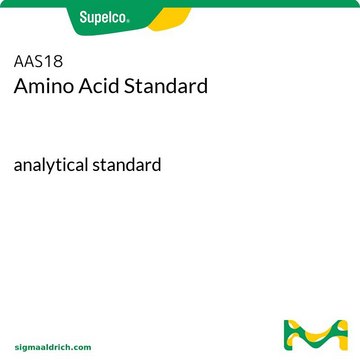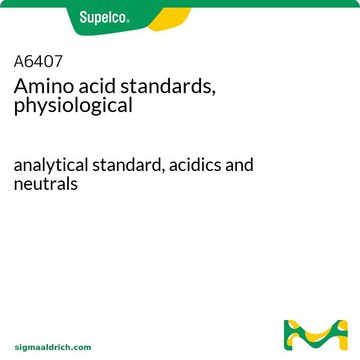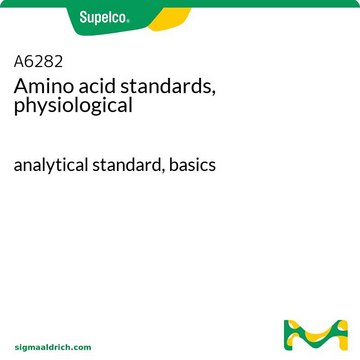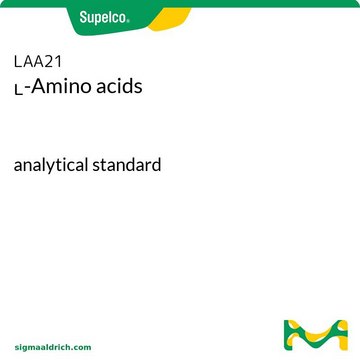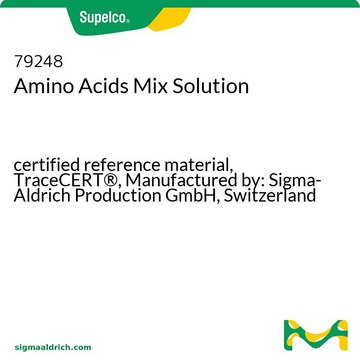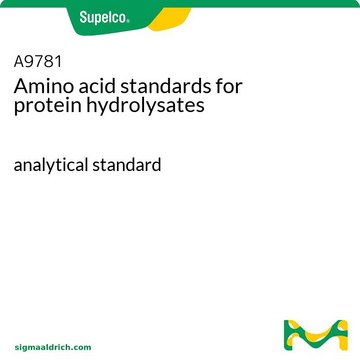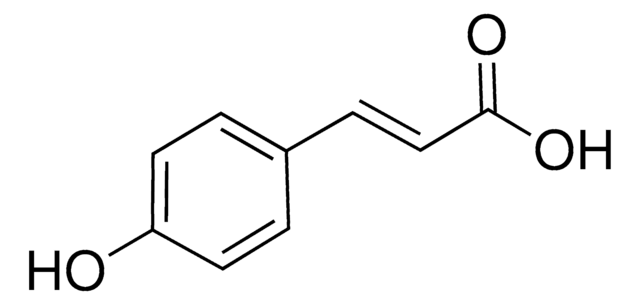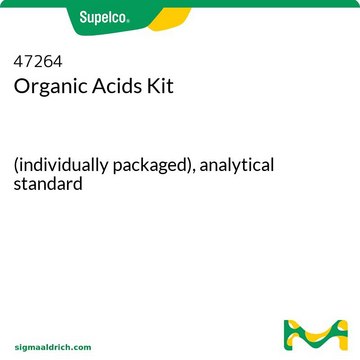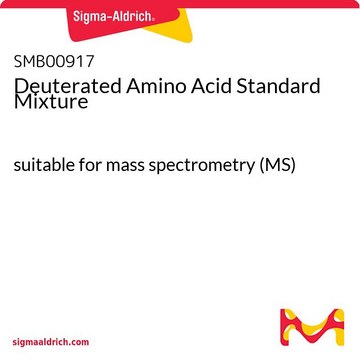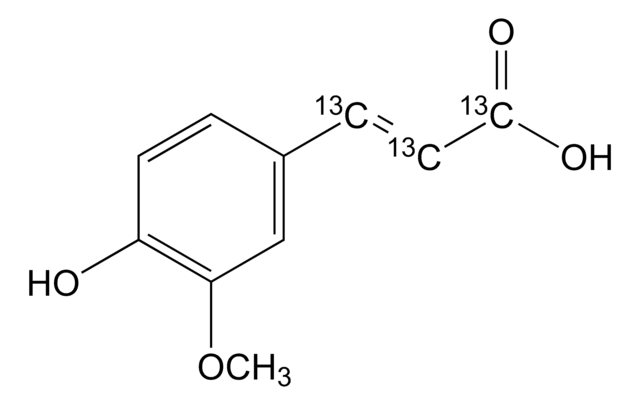A9906
Amino acid standards, physiological
analytical standard, acidics, neutrals, and basics
Sign Into View Organizational & Contract Pricing
All Photos(1)
About This Item
Recommended Products
grade
analytical standard
analyte chemical class(es)
amino acids, peptides, proteins
technique(s)
HPLC: suitable
gas chromatography (GC): suitable
color
colorless
application(s)
food and beverages
format
neat
storage temp.
2-8°C
Looking for similar products? Visit Product Comparison Guide
Application
Refer to the product′s Certificate of Analysis for more information on a suitable instrument technique. Contact Technical Service for further support.
Components
The following components are included in the amino acid standard:
- L-Alanine
- Ammonium chloride
- L-Arginine
- L-Aspartic acid
- L-Cystine
- L-Glutamic acid
- Glycine
- L-Histidine
- L-Isoleucine
- L-Leucine
- L-Lysine
- L-Methionine
- L-Phenylalanine
- L-Proline
- L-Serine
- L-Threonine
- L-Tyrosine
- L-Valine
- β-Alanine
- L-α-Amino-n-butyric acid
- γ-Amino-n-butyric acid
- DL-β-Aminoisobutryic acid
- L-Anserine
- L-Carnosine
- L-Citrulline
- L-Creatinine
- Cystathionine
- Ethanolamine
- L-Homocystine
- δ-Hydroxylysine
- Hydroxy-L-proline
- 1-Methyl-L-histidine
- 3-Methyl-L-histidine
- L-Ornithine
- Sarcosine
- Taurine
- L-Tryptophan
- Urea
Other Notes
Amino acids and related compounds are 0.5 μmole/mL in 0.2 N lithium citrate, pH 2.2 containing 0.1% phenol and 2% thiodiglycol.
related product
Product No.
Description
Pricing
Storage Class Code
12 - Non Combustible Liquids
WGK
WGK 2
Flash Point(F)
Not applicable
Flash Point(C)
Not applicable
Regulatory Information
监管及禁止进口产品
Choose from one of the most recent versions:
Already Own This Product?
Find documentation for the products that you have recently purchased in the Document Library.
Huibin Qin et al.
Frontiers in microbiology, 7, 1311-1311 (2016-09-10)
Suanzhou as a traditional Chinese gruel is fermented from proso millet and millet. The biochemical analysis showed Suanzhou had relatively high concentrations of lactic acid, acetic acid, and free amino acids. The metagenomics of Suanzhou were studied, with the analysis
Diogo Antonio Alves de Vasconcelos et al.
The Journal of nutritional biochemistry, 70, 202-214 (2019-06-25)
L-Glutamine (L-Gln) supplementation has been pointed out as an anticatabolic intervention, but its effects on protein synthesis and degradation signaling in skeketal muscle are still poorly known. The effects of L-Gln pretreatment (1 g kg-1 day-1 body weight for 10
Eli K Moore et al.
Frontiers in microbiology, 6, 637-637 (2015-07-16)
Microbial decomposition of organic matter is an essential process in the global carbon cycle. The soil bacteria Pseudopedobacter saltans and Flavobacterium johnsoniae are both able to degrade complex organic molecules, but it is not fully known how their membrane structures
C Hellmuth et al.
Nutrition, metabolism, and cardiovascular diseases : NMCD, 26(9), 786-796 (2016-05-06)
Moderately reduced maternal nutrient availability during pregnancy has adverse effects on the fetuses' growth and metabolism during and after pregnancy. The aim of this study was to explore effects of maternal nutrition restriction (MNR) on key metabolites of the fetal
Sneha Bansode et al.
Scientific reports, 10(1), 3397-3397 (2020-02-27)
Collagen fibrils are central to the molecular organization of the extracellular matrix (ECM) and to defining the cellular microenvironment. Glycation of collagen fibrils is known to impact on cell adhesion and migration in the context of cancer and in model
Our team of scientists has experience in all areas of research including Life Science, Material Science, Chemical Synthesis, Chromatography, Analytical and many others.
Contact Technical Service